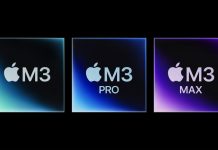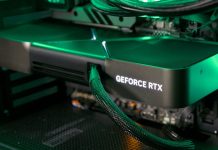New $549 graphics card is the more logical successor to the RX 6800 XT.
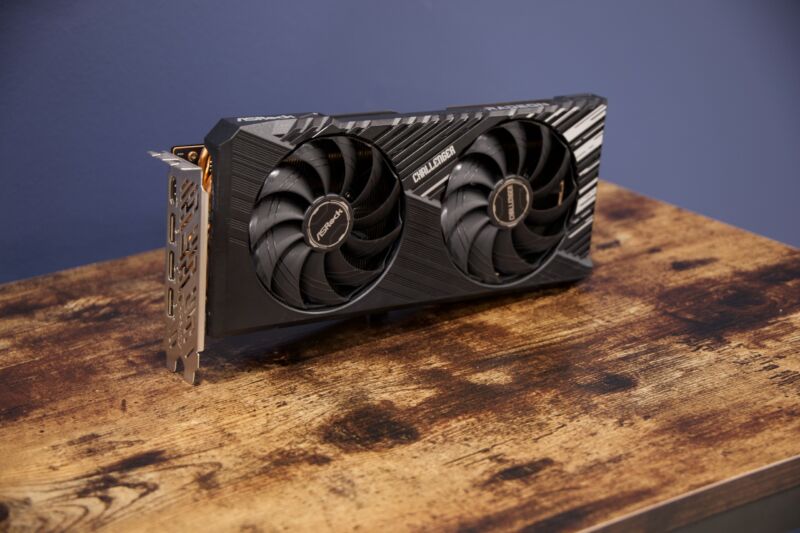
In July 2023, AMD released a new GPU called the “Radeon RX 7900 GRE” in China. GRE stands for “Golden Rabbit Edition,” a reference to the Chinese zodiac, and while the card was available outside of China in a handful of pre-built OEM systems, AMD didn’t make it widely available at retail.
Review: AMD’s Radeon RX 7700 XT and 7800 XT are almost great
That changes today—AMD is launching the RX 7900 GRE at US retail for a suggested starting price of $549. This throws it right into the middle of the busy upper-mid-range graphics card market, where it will compete with Nvidia’s $549 RTX 4070 and the $599 RTX 4070 Super, as well as AMD’s own $500 Radeon RX 7800 XT.
We’ve run our typical set of GPU tests on the 7900 GRE to see how it stacks up to the cards AMD and Nvidia are already offering. Is it worth buying a new card relatively late in this GPU generation, when rumors point to new next-gen GPUs from Nvidia, AMD, and Intel before the end of the year? Can the “Golden Rabbit Edition” still offer a good value, even though it’s currently the year of the dragon?
Meet the 7900 GRE
| RX 7900 XT | RX 7900 GRE | RX 7800 XT | RX 6800 XT | RX 6800 | RX 7700 XT | RX 6700 XT | RX 6750 XT | |
|---|---|---|---|---|---|---|---|---|
| COMPUTE UNITS (STREAM PROCESSORS) | 84 (5,376) | 80 (5,120) | 60 (3,840) | 72 (4,608) | 60 (3,840) | 54 (3,456) | 40 (2,560) | 40 (2,560) |
| BOOST CLOCK | 2,400 MHz | 2,245 MHz | 2,430 MHz | 2,250 MHz | 2,105 MHz | 2,544 MHz | 2,581 MHz | 2,600 MHz |
| MEMORY BUS WIDTH | 320-bit | 256-bit | 256-bit | 256-bit | 256-bit | 192-bit | 192-bit | 192-bit |
| MEMORY CLOCK | 2,500 MHz | 2,250 MHz | 2,438 MHz | 2,000 MHz | 2,000 MHz | 2,250 MHz | 2,000 MHz | 2,250 MHz |
| MEMORY SIZE | 20GB GDDR6 | 16GB GDDR6 | 16GB GDDR6 | 16GB GDDR6 | 16GB GDDR6 | 12GB GDDR6 | 12GB GDDR6 | 12GB GDDR6 |
| TOTAL BOARD POWER (TBP) | 315 W | 260 W | 263 W | 300 W | 250 W | 245 W | 230 W | 250 W |
The 7900 GRE slots into AMD’s existing lineup above the RX 7800 XT (currently $500-ish) and below the RX 7900 (around $750). Technologically, we’re looking at the same Navi 31 GPU silicon as the 7900 XT and XTX, but with just 80 of the compute units enabled, down from 84 and 96, respectively. The normal benefits of the RDNA3 graphics architecture apply, including hardware-accelerated AV1 video encoding and DisplayPort 2.1 support.Advertisement
The 7900 GRE also includes four active memory controller die (MCD) chiplets, giving it a narrower 256-bit memory bus and 16GB of memory instead of 20GB—still plenty for modern games, though possibly not quite as future-proof as the 7900 XT. The card uses significantly less power than the 7900 XT and about the same amount as the 7800 XT. That feels a bit weird, intuitively, since slower cards almost always consume less power than faster ones. But it does make some sense; pushing the 7800 XT’s smaller Navi 32 GPU to get higher clock speeds out of it is probably making it run a bit less efficiently than a larger Navi 31 GPU die that isn’t being pushed as hard.
- Andrew Cunningham
- Andrew Cunningham
- Andrew Cunningham

When we reviewed the 7800 XT last year, we noted that its hardware configuration and performance made it seem more like a successor to the (non-XT) Radeon RX 6800, while it just barely managed to match or beat the 6800 XT in our tests. Same deal with the 7900 GRE, which is a more logical successor to the 6800 XT. Bear that in mind when doing generation-over-generation comparisons.
Performance and power use
On paper, the 7900 GRE looks like it ought to split the difference between the 7900 XT and 7800 XT, with its 7900 XT-ish number of compute units (CUs) and its 7800 XT-ish memory subsystem.
In reality, a combination of lower clock speeds and the 256-bit memory interface make the 7900 GRE perform more like a 7800 XT than a 7900 XT in our testing, leaving a fairly wide gap between AMD’s second- and third-best consumer GPUs. In many of the games in our test suite—a couple of older Assassin’s Creed titles and Cyberpunk 2077 with ray-tracing disabled—the two cards actually perform pretty similarly. Like the 7800 XT, the 7900 GRE is a serviceable 4K graphics card, especially if you can use FSR or turn the settings down a notch or two, but in more demanding games, it’s a better fit for a high-refresh-rate 1440p monitor instead.
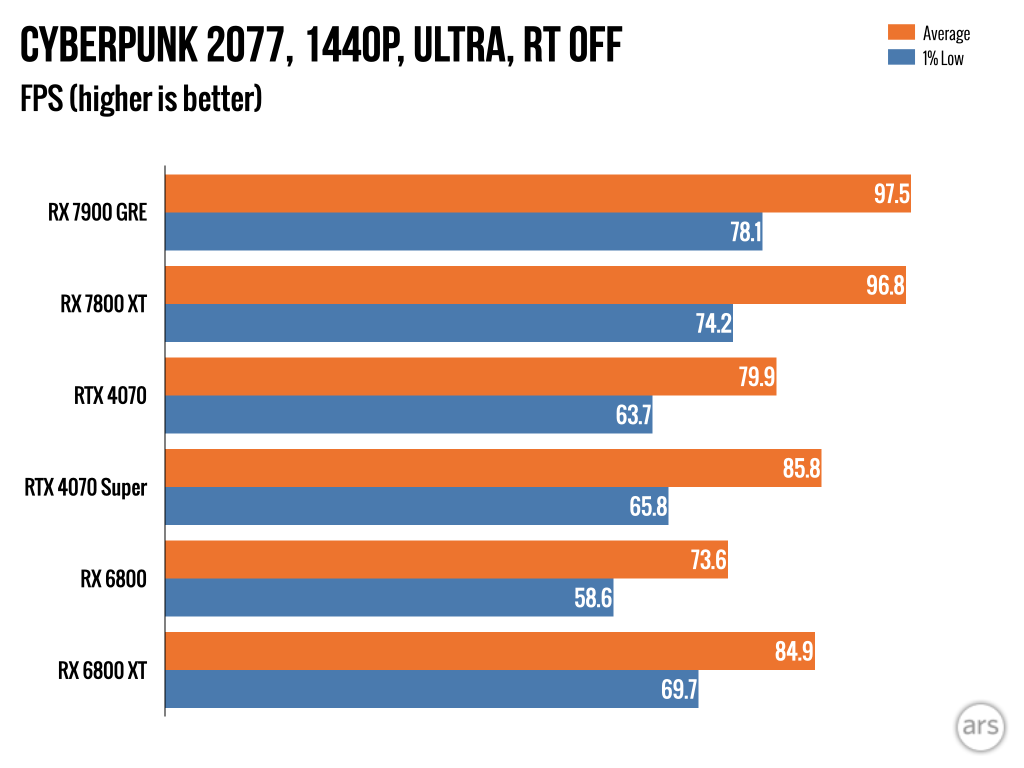
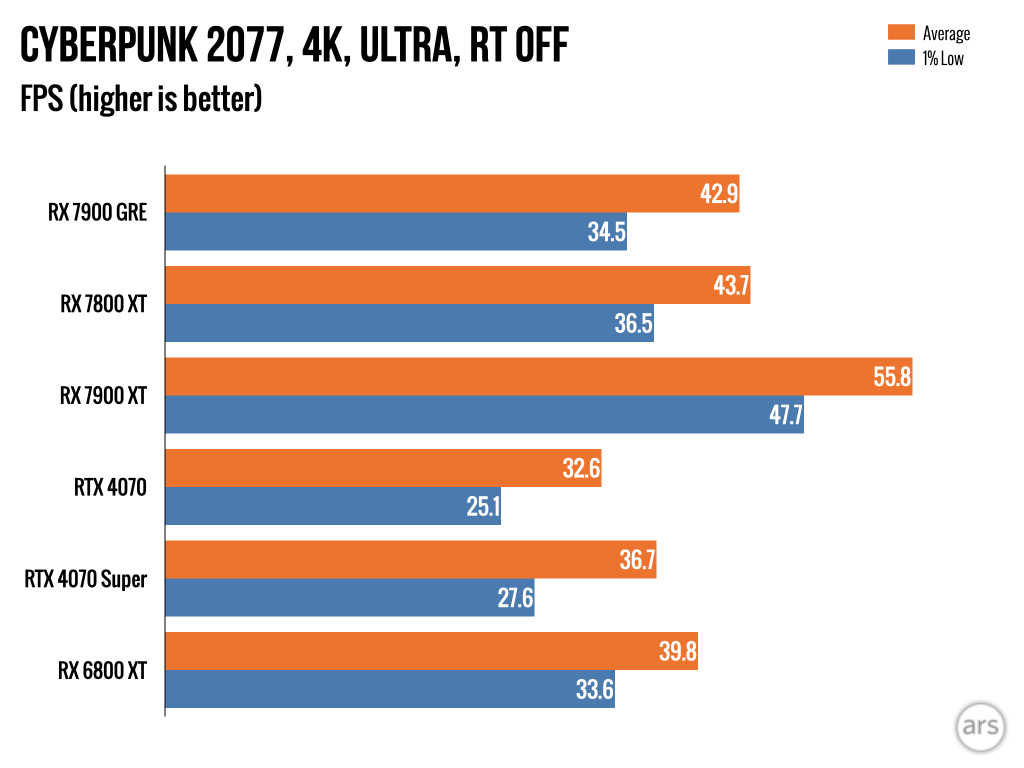
At 1440p in non-ray-traced games and games with relatively light ray-tracing effects like Forza Horizon 5, the RX 7900 GRE usually matches or slightly beats the similarly priced non-Super RTX 4070 and trades blows with the $600 4070 Super. At 4K, the 7900 GRE tends to outrun both Nvidia cards a bit, likely a product of its wider memory interface (the 4GB of extra RAM might be helping, too). But in games with heavier ray-tracing effects like Cyberpunk 2077 or Returnal, both Nvidia cards assert their typical dominance. This is the same dynamic we’ve seen across AMD and Nvidia’s lineups for years now, and there’s not much else to be said about it; playing games with ray-tracing enabled is possible on AMD’s GPUs, but it’s still a notable weak spot for otherwise good graphics cards.
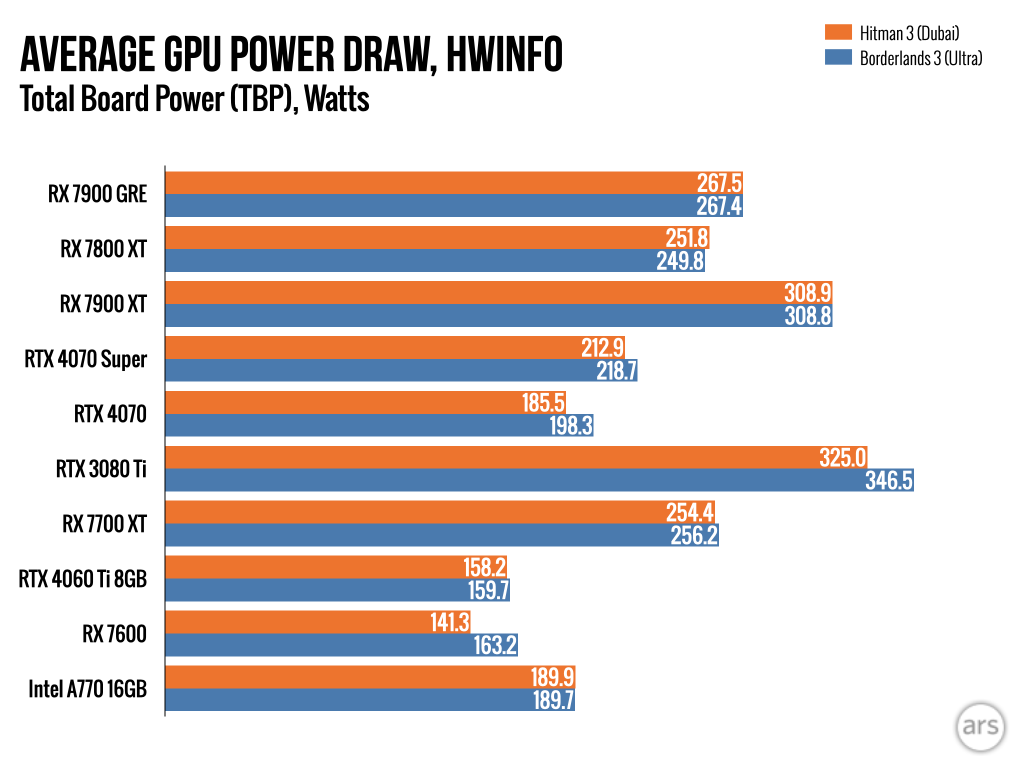
Though the 7900 GRE’s on-paper power consumption should be a smidge lower than the 7800 XT’s, in our testing, its power usage ended up being slightly higher while playing games at 4K, at least for the ASRock model we tested. The 7900 GRE is more power efficient than the old RX 6800 XT, though it still looks pretty bad next to the 4070 or 4070 Super (bearing in mind the usual caveat that comparing software-measured power usage numbers between Nvidia, AMD, and Intel can be imprecise since you’re relying on the card to report its power usage accurately, and all manufacturers will handle it slightly differently).
Another fine, if not inspiring, AMD GPU
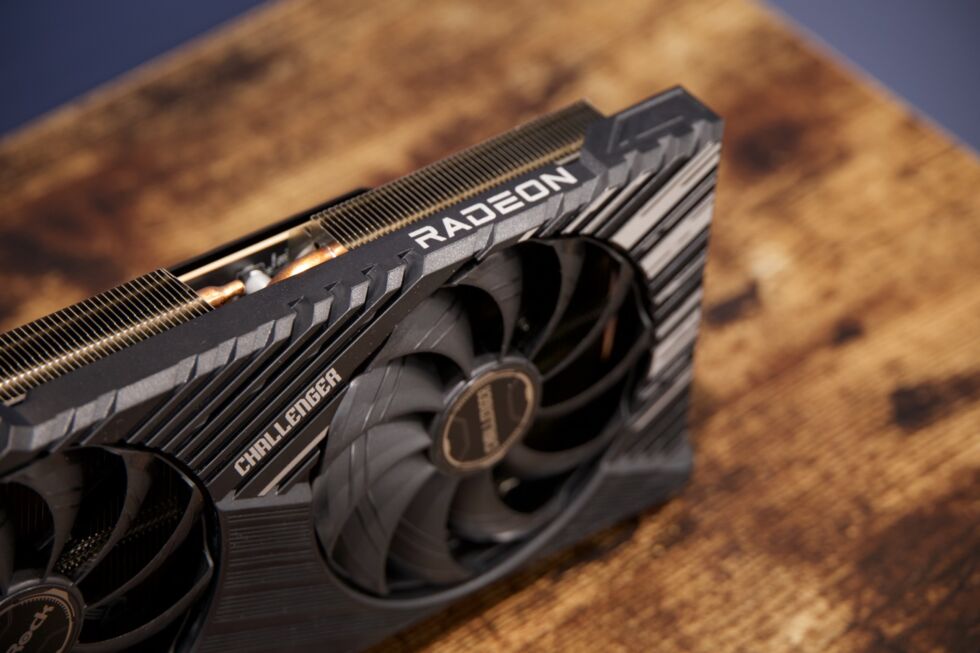
Considered on its own, there’s nothing wrong with the Radeon RX 7900 GRE. It stacks up reasonably well against Nvidia’s similarly priced non-Super RTX 4070, and it’s a bit faster and more power-efficient than the RX 6800 XT, the most directly comparable last-gen Radeon card. I wish it were branded differently—it performs a bit more like the RX 7800 XT than it does like either of the other RX 7900-series cards—but the price and performance are ultimately more important than what it says on the box.Advertisement
Its biggest problem is the same one AMD has had throughout this GPU generation. Most of AMD’s offerings are faster than what Nvidia is offering for the same price, but it always comes with the same collection of “ifs”: if you don’t care about great ray-tracing performance, if you don’t care about CUDA or Nvidia-optimized AI and GPU compute workloads, if you don’t care about the best possible power efficiency, if you don’t care about DLSS upscaling.
That collection of caveats would feel less important if AMD were pricing its cards more aggressively, but that’s not the approach the company is taking. It’s hard to see the RX 7900 GRE appealing to anyone who wasn’t convinced by the 7800 XT, and there are strong arguments to be made in favor of spending a little more for an RTX 4070 Super instead. The $500-to-$600 price range is already populated by a bunch of these 1440p-to-4K graphics cards; the 7900 GRE is perfectly fine, but it doesn’t do much to stand out from the crowd, either.
The good
- Solid performance
- Outdoes the 4070 and 4070 Super in many cases, but particularly at 4K in non-ray-traced games
- A good (though not exceptional) value
- More power-efficient than last-gen Radeon GPUs
The bad
- “7900” branding feels a bit unearned, and there are games where it struggles to outrun a 7800 XT
- AMD’s typical weak points, most notably ray-tracing performance and power efficiency relative to Nvidia
The ugly
- It’s not the year of the rabbit anymore
Listing image by Andrew Cunningham


